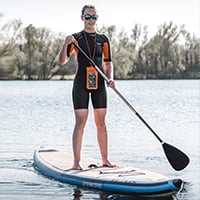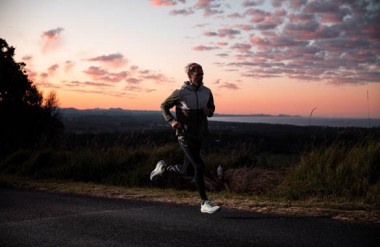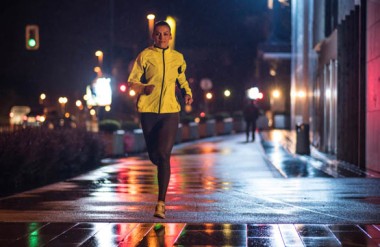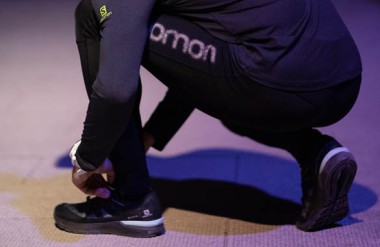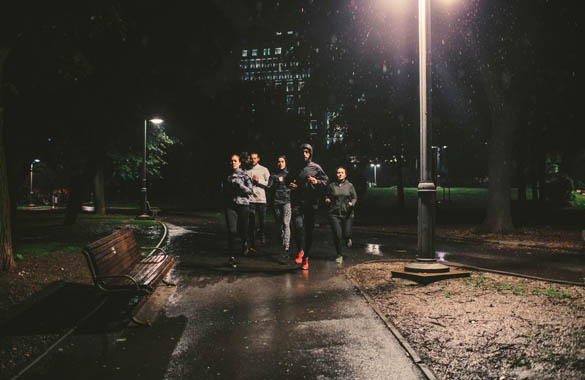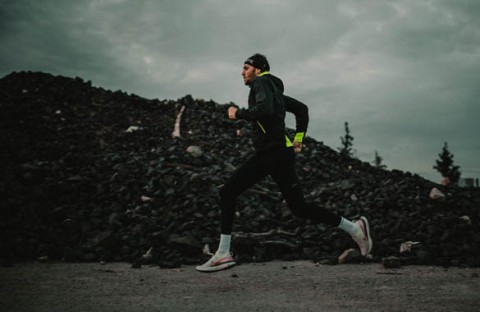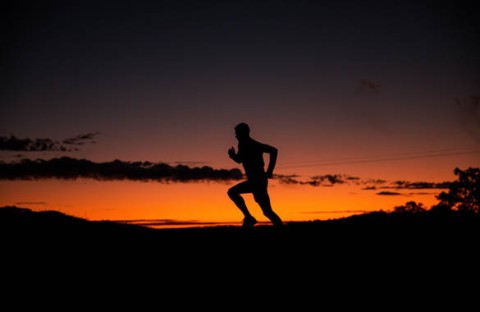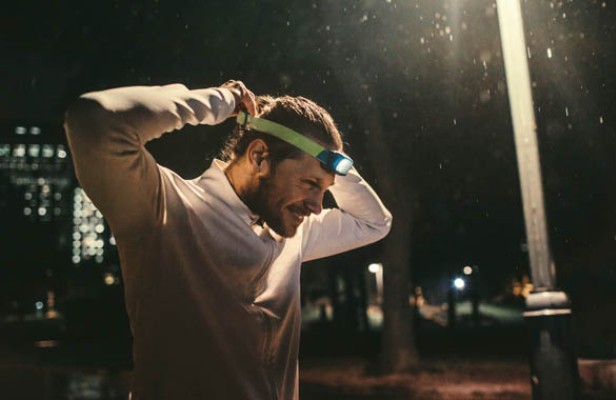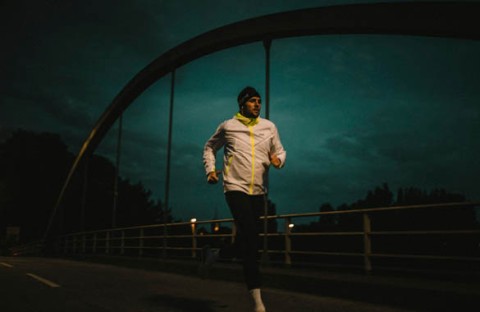Embrace the dark
Winter is coming and, for passionate runners, running in the dark is inevitable.
With the clocks going back an hour next week, marking the arrival of winter, it means less daylight and more darkness.
Running in winter has a special flavour for runners and requires more dedication and a different assortment of gear.
Stay true to your running over winter, and you’ll make leaps and bounds.
However, to get in our runs between now and when the clocks get adjusted an hour forward again, means most of us must face heading out either first thing in the morning or after work when it’s dark out. It’s either that or stay indoors and use a treadmill. No thanks – give me fresh air and the night sky over artificial lighting and the drone of a treadmill any day.
Besides, running when the stars are still twinkling in the sky is something to embrace and enjoy. With a headlamp and some care, you can even get off-road and go trail running in your local forest and hills. Yes, there are some personal safety precautions to take, but once you know these, you’ll feel confident running during the inky hours and find yourself delighting in it. So let’s start with the positives and then talk safety.
The benefits of running in the dark
1. Imagine you’re a shiny red Ferrari
First up, thanks to a trick of human perception – which scientists called ‘optic flow influence’ – we feel like we run faster at night. This is due to the lack of light hiding spatial cues that tell us where our bodies are in relation to our surroundings. Sure, you’re still be running at your usual pace, but feeling faster without increasing your effort is still cool.
2. Improve your sixth sense
Proprioception is sometimes referred to as the body’s sixth sense. In a nutshell, it’s the body’s ability to sense where it is in space and to know, intuitively, how to move accordingly. Running in the dark can help to improve this because we must depend more on feel and less on sight. For trail runners, this is especially important to develop because of the uneven paths they run on.
3. Enjoy the atmosphere
First thing in the morning when most of us are still tucked up in bed or at night when most of us are sprawled out on the couch and watching television, the world is a different place. It’s more peaceful, has a different vibe, certain aspects missed during daylight come to the fore, and wild animals are more active. There’s something magic about the dark hours. Enjoy it.
4. Embrace the present moment
One of the safety precautions for running in the dark – explained below – is to not use earbuds to listen to anything. The upside to this, is it means you can fully tune in to the present moment. What do you hear, smell, feel and see? Try listening to the sound of your footsteps, your breath, the wind blowing by you, the birds in the trees. In this way running in the dark can become a mindfulness practice.
5. Focus on form
When many of the visual distractions are stripped away, when there’s less noise, less people out and about, running at night is an opportunity to focus on improving your running form and economy. Use it to zone in on your foot strike (which part of your feet strike the ground first – should be the midfoot), running cadence (number of steps you take per minute), your posture, head position and gaze and arm movement. Spending time improving this eventually makes running more enjoyable and efficient.
Prepare for the cold season
- Everything you need to know about running in winter
10 safety tips for running in the dark
1. Know where you’re going
This one is obvious, but important. Especially if you live in a big city. You don’t want to jog down any unfamiliar dark alleys. Instead, choose a route you already know well and start with that. Give yourself time to get comfortable running in low light conditions.
2. Start out with a well-lit route
If running in the dark is new to you, consider choosing a route with plenty of street lighting to start out. Again, don’t jump in the deep end too soon; give your body and senses time to adjust.
3. Go slow out the gate
This builds on the above tips: if you’re not acquainted to running in low light, then slow down and let yourself adjust. Running more slowly is also an opportunity to focus on aspects of your running form. For example, focus on your foot strike and practice landing on your midfoot rather than your heels.
4. Tell someone where you’re going
Let someone know where you’re going and when you’ll be back. You can also use an app like ‘Find me’ so your loved ones can see where you are. This is important because it means your friends or family can raise the alarm if you don’t get home when you said you would.
5. Make yourself visible
This one is super important, especially if you’ll be running in an area with vehicle and bicycle traffic. Wear bright clothing and a headlamp and buy yourself an assortment of reflectors so you are clearly visible to cyclists and drivers from a distance. Use “biological motion” for increased visibility; this means lighting up your joints – ankles, knees, wrists, and elbows, not the torso – so motorists and cyclists recognize you as a moving person.
6. Unplug those earbuds
As great as listening to music is while out on a run, it’s easy to be swept away by it and for it to block out sounds – like the noise of an oncoming tram – that are important to pay attention to. So take out the earbuds and tune in to the sounds of your surroundings. You can turn this into a mindfulness exercise by practicing listening to all the sounds at once and not letting your attention dart from one to another.
7. Run with others or a dog
If you feel anxious about running in the dark alone, consider taking shelter of safety in numbers. You might be more at ease running with a friend or in a group. That way you can fully relax and enjoy the moment without looking over your shoulder. Same applies to running with Brutus the Rottweiler – no one will mess with you.
8. Take your phone
Have it on you, but don’t use it unless you really need to. Install and set up a medical ID app so in the unlikely situation something does happen to you when paramedics and police arrive, they can determine who you are, who to contact and whether you have medical conditions without them needing to unlock your phone.
9. Stick to the footpath
Choose running routes that have footpaths. Minimise time running on roads to avoid the danger of vehicle traffic. And if that’s unavoidable, run on the same side of the road as the traffic coming towards you. That way, you can see what’s coming and move if necessary.
10. Wait for the green
As tempting as jaywalking may be, ignore the urge. When you approach an intersection running it’s possible to miss something, like a bicycle without a light. Instead of rushing, jog on the spot, stretch, enjoy a deep breath or two, and wait for the green before you cross. Your family will appreciate the patience.
Embrace it!
The world is a different place in the early morning and at night. The low light and visibility, the flickering streetlights, the warm, cozy light shining out of house and building windows and the hushed atmosphere all create a peaceful, mysterious, and intimate feeling. Follow the above and running in the dark can be your own magical time. It can be when you come back to yourself, get into rhythm and freshen up. It’s either that or learn to tolerate the drone of the treadmill.
Recommended gear
Everything you need
- Long sleeve running shirts with reflective details
- Full length running tights with reflective details
- Windbreaker running jackets with bright reflective details
- A bright headlamp
- Reflective bands for wrapping around joints
- Running shoes suited to winter with more aggressive grip and reflective trim.
- Bright windstopper beanie





























